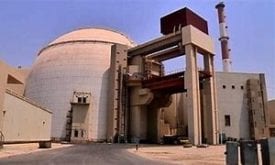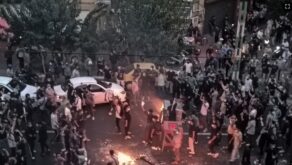VOA – Russia’s use of an Iranian base to launch airstrikes in Syria jolted the U.S. and its allies in the region, but the timing may have more to do with concerns about the fate of the Syrian regime than the need of Moscow or Tehran to send a message.

Both Russia and Iran have become increasingly concerned about the most recent rebel offensive in Aleppo city, which made progress against regime forces in the south and east despite intense fighting in recent weeks.
“It’s all hands on deck to get the upper hand in that battle space,” a U.S. counterterrorism official said on condition of anonymity.
The Russian Defense Ministry said Tuesday that Tu-22M3 “Backfire” bombers and Su-34 “Fullback” fighter-bombers took off from Hamedan air base in Iran to hit what the ministry said were the Islamic State terror group and al-Qaida-linked Jabhat al-Nusra in Aleppo as well as in Deir ez-Zor and Idlib.
Still, the Russian strikes are only part of what appears to be a rejuvenated effort to bolster forces loyal to Syrian President Bashar al-Assad.
“Iran is continuing to provide support for the Syrian regime and support efforts to contain opposition members in Aleppo,” according to a U.S. intelligence official.
Increase in militias
Much of that support seems to be coming on the ground, with indication of a significant influx of Iranian-backed militias.
“They’ve been continuing to pump Shia jihadists in,” said Phillip Smyth, a University of Maryland researcher who specializes in Shia militia activity.
Smyth said a spike in recruiting last year left Iran with an estimated 14,000 militia fighters, in addition to about 3,500 Iranian troops. But he said recruitment efforts aimed at Afghanistan and Lebanon have not stopped.
“I also have seen an increase in ‘new’ Iraqi groups pushing the unified Iraqi-Syrian jihad message,” Smyth said. “So there’s a strong likelihood that something else is up.”
Likewise, the Russian movement seems to have been in the works for some time. Some Russian bombers and transport aircraft reportedly were stationed at Hamedan as far back as November 2015.
“Iranian fighters have been seen escorting Russian bombers as they transit Iranian airspace,” said Marie Donovan, an Iran analyst with the American Enterprise Institute’s Critical Threats Project.
Residents inspect their damaged homes after an airstrike on rebel-held Old Aleppo, Syria, Aug. 15, 2016.
Residents inspect their damaged homes after an airstrike on rebel-held Old Aleppo, Syria, Aug. 15, 2016.
More recent images obtained by Stratfor, a U.S.-based global intelligence company, indicate Russia had at least three or four of its Backfires and some Fullback aircraft stationed at Hamedan in the weeks or months leading up to the strike. And Stratfor believes it would not have taken much work to prepare Hamedan to handle the larger Backfire bombers.
“We now have Russian aviation, Russian aircraft directly based in Iran,” said Stratfor senior military analyst Omar Lamrani. “It’s an escalation.”
“The fact that the Russians were given this access tells us a lot about the degree to which the relationship between Moscow and Iran has evolved, especially as they pursue the same goals in Syria,” he said.
Cause for concern?
“It’s unfortunate but not surprising or unexpected,” State Department spokesman Mark Toner said Tuesday, noting Russia’s use of the air base might even violate the U.N. Security Council resolution on Iran’s nuclear program.
Toner also cast doubt on Moscow’s claims it struck only IS targets, saying Tuesday’s action appeared to be part of a familiar pattern in which Russian jets “continually, predominantly target moderate Syrian opposition forces.”
“We’re not going to turn our back on moderate Syrian opposition forces,” he said.
As for the Russian bombers aircraft used in Tuesday’s airstrikes in Syria, another U.S. official, speaking on the condition of anonymity said it appears they returned to Russia and not to Iran.
Still, there are questions as to whether the Russian planes in Iran were just part of a rotational force that will be based at Hamedan briefly or part of a more permanent deployment that could alter the balance of power in the region.
Russia digging in
Christopher Harmer, senior naval analyst at the Institute for the Study of War, leans toward the latter.
“This looks like Russia is acknowledging the limitations of operating from Syrian bases and is digging in for a long-term campaign based out of Iran,” Harmer said, pointing to the ever-present threat of suicide bombers and rocket attacks in Syria.
“The maintenance facilities in Iran will be much higher quality, and the Russian air force will have unlimited supplies of electricity and fresh water, both of which are essential for ongoing maintenance on the aircraft,” he added.
But even if it is just a temporary, rotational Russian force, Stratfor’s Lamrani said it could be cause for concern.
“The influx of Russian hardware into Iran, Russian personnel being based at an Iranian airbase, signals a shift in Iran’s status in the region,” he warned.
“That says a lot to the Saudis. That says a lot to the Gulf Cooperation Council,” Lamrani said. “They’re going to be asking such questions as, ‘If we do come into conflict with Iran, does that also mean we are coming to come into conflict with Russia?’ ”
VOA State Department correspondent Steve Herman contributed to this story.
 Shabtabnews In this dark night, I have lost my way – Arise from a corner, oh you the star of guidance.
Shabtabnews In this dark night, I have lost my way – Arise from a corner, oh you the star of guidance.



